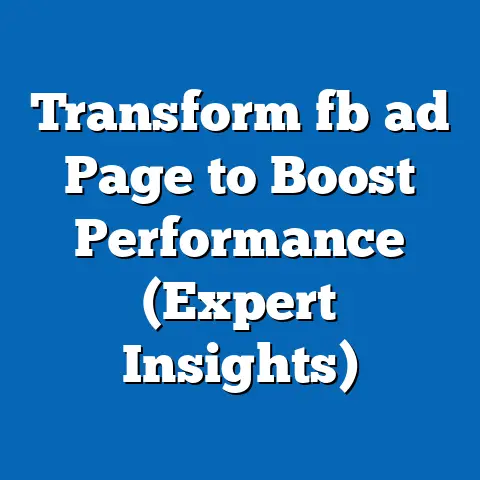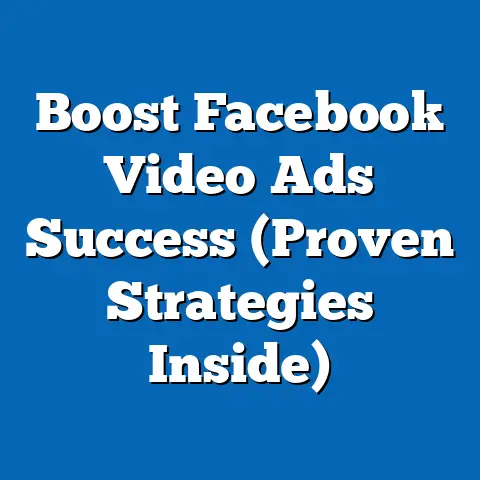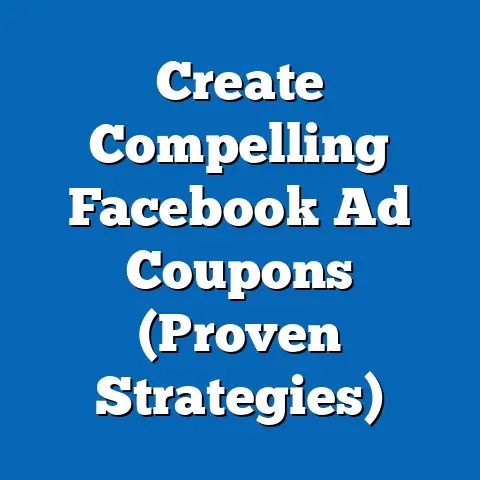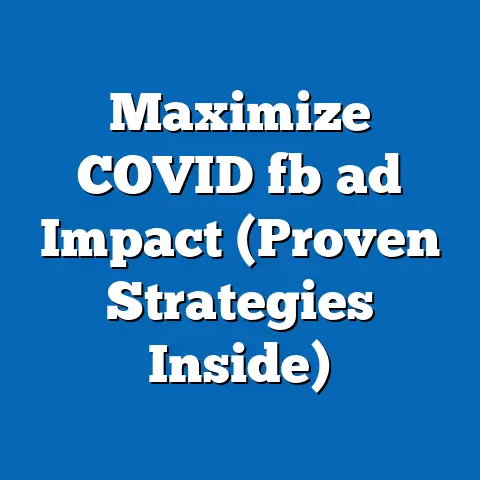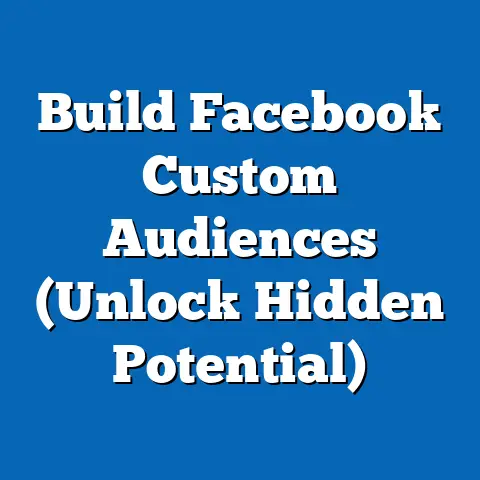Mastering Facebook Ads with 5 Easy Steps (Expert Guide)
Let’s be honest, diving into Facebook Ads can feel like trying to assemble IKEA furniture without the instructions. I remember a friend, bless his heart, who tried running a Facebook ad campaign for his… cat’s birthday. Yes, you read that right. He ended up targeting dog lovers in Antarctica. Needless to say, Mittens didn’t get many RSVP’s.
Facebook Ads can seem complex, but it doesn’t have to be rocket science. In this guide, I’m going to break down how to master Facebook Ads in just five easy steps. Think of it as your shortcut to advertising success, without the feline faux pas. Ready to turn your advertising game from “meow-ch” to “wow!”? Let’s dive in!
Understanding the Basics of Facebook Ads
Facebook Ads are essentially paid messages or sponsored content that businesses use to reach their target audience on Facebook and Instagram. They’re a powerful tool because they allow you to reach people based on specific demographics, interests, behaviors, and more. Forget blasting your message into the void – Facebook Ads help you laser-focus your efforts on those most likely to convert.
Think of the Facebook Ads ecosystem as a giant party. Everyone’s there to have a good time, but businesses are trying to be the “life of the party” by capturing attention. To do that, you need to understand the different types of ads available. There’s the classic image ad, the engaging video ad, the showcasing carousel ad, and many more.
But before you even think about the type of ad, remember this: knowing your audience is crucial. You wouldn’t try to sell snowboards to someone living in the Sahara, would you? Sometimes, who we think our audience is, isn’t actually who they are. That’s where audience research comes in, and it’s going to be key in Step 2.
Takeaway: Facebook Ads are powerful tools for reaching specific audiences, but understanding the basics and knowing your audience is key to success.
Step 1 – Define Your Goals
Before you even think about designing your ad, ask yourself: what do I want to achieve? Setting clear, measurable goals is the foundation of any successful ad campaign. Are you trying to increase brand awareness? Generate leads? Drive sales? The clearer your goal, the easier it will be to measure your success and optimize your campaign.
I’ve seen some goals that are… well, let’s just say less than helpful. “I just want people to like my page” or “I want to be famous” are not goals. They’re aspirations! And while there’s nothing wrong with wanting those things, they don’t give you anything to measure.
Instead, use the SMART criteria:
- Specific: What exactly do you want to achieve? (e.g., “Increase website traffic by 20%”)
- Measurable: How will you track your progress? (e.g., “Track website clicks and conversions through Facebook Ads Manager”)
- Achievable: Is your goal realistic given your budget and resources? (e.g., Don’t expect to become a millionaire overnight)
- Relevant: Does your goal align with your overall business objectives? (e.g., Does increasing website traffic lead to more sales?)
- Time-bound: When do you want to achieve your goal? (e.g., “Within the next 3 months”)
Let me paint a picture for you. Imagine you’re planning a road trip without a destination. You might have a vague idea of “going somewhere fun,” but without a specific place in mind, you’ll end up driving aimlessly, wasting gas, and probably getting lost. The same goes for your ad campaign. Without clear goals, you’ll be throwing money into the Facebook abyss, hoping for a miracle.
Takeaway: Define SMART goals before launching your ad campaign to ensure you’re measuring the right metrics and driving meaningful results.
Step 2 – Know Your Audience
Okay, you’ve got your goals. Now it’s time to figure out who you’re trying to reach. Audience targeting on Facebook is where the magic happens. You can target people based on location, demographics (age, gender, education), interests (hobbies, passions), behaviors (purchase history, online activity), and even connections (friends of people who like your page).
Facebook Audience Insights is your best friend here. It’s a free tool that allows you to learn more about your target audience. You can see their demographics, interests, page likes, and even their purchase behavior. Use this data to create detailed audience personas.
Think of targeting like dating. You wouldn’t propose to someone you just met at a bar, right? You’d want to get to know them first, find out their interests, and see if you’re a good match. The same goes for your audience. The more you know about them, the better you can tailor your ads to their needs and desires.
Here’s a fun exercise: create audience personas. Give them names, imagine their daily lives, and think about what motivates them. For example:
- “Marketing Mary”: A 35-year-old marketing manager who loves reading industry blogs, attending webinars, and trying new software.
- “Tech-Savvy Tom”: A 28-year-old entrepreneur who’s always on the lookout for the latest gadgets and apps.
- “Budget-Conscious Betty”: A 45-year-old small business owner who’s looking for affordable marketing solutions.
By creating these personas, you can better understand your audience’s needs and create ads that resonate with them.
Takeaway: Use Facebook Audience Insights to understand your audience’s demographics, interests, and behaviors. Create audience personas to tailor your ads to their specific needs and desires.
Now it’s time to create ad content that grabs their attention and compels them to take action. This means eye-catching visuals, compelling copy, and strong calls to action.Let’s talk visuals. Forget those overly cheesy stock photos that look eerily staged. No one’s buying that. Instead, use high-quality images or videos that are relevant to your product or service. Show your product in action, highlight its benefits, and make it visually appealing.
Now, let’s talk copy. No one wants to read a novel when they’re scrolling through their feed! Keep your copy concise, clear, and engaging. Focus on the benefits of your product or service, not just the features. Use strong verbs and persuasive language to encourage action. And for goodness sake, proofread! Nothing screams “unprofessional” like a typo in your ad copy.
And finally, let’s talk calls to action. Tell people exactly what you want them to do. “Shop Now,” “Learn More,” “Sign Up,” “Download Now” – these are all strong calls to action that tell people what to do next. Make your call to action clear, prominent, and easy to click.
Don’t be afraid to get creative with your ad visuals. Use emojis, memes, or funny graphics to grab attention. Humor can be a powerful tool for engaging your audience, but make sure it’s appropriate for your brand and target audience.
Takeaway: Create engaging ad content with eye-catching visuals, compelling copy, and strong calls to action. Don’t be afraid to get creative and use humor to grab attention.
Step 4 – Set Your Budget and Bid Strategy
Okay, let’s talk money. Setting your budget and bid strategy can feel daunting, but it doesn’t have to be. Facebook offers two main budgeting options: daily budget and lifetime budget.
- Daily Budget: The average amount you’re willing to spend each day on your ad campaign. Facebook will try to spend close to this amount each day, but it may fluctuate slightly.
- Lifetime Budget: The total amount you’re willing to spend on your ad campaign over its entire duration. Facebook will try to distribute your budget evenly over the lifetime of the campaign.
Which one should you choose? It depends on your goals and your campaign duration. If you’re running an ongoing campaign, a daily budget might be a good choice. If you’re running a limited-time promotion, a lifetime budget might be better.
Now, let’s talk bidding strategies. This is like deciding how much you’re willing to pay for a slice of pizza – just don’t get too carried away! Facebook offers several bidding strategies, including:
- Lowest Cost: Facebook will try to get you the most results for your budget, without considering the cost per result.
- Cost Per Result Goal: You tell Facebook how much you’re willing to pay for each result (e.g., cost per click, cost per conversion), and Facebook will try to achieve that goal.
- Value Optimization: Facebook will try to get you the most value for your budget, by showing your ads to people who are most likely to make a purchase.
Which bidding strategy should you choose? It depends on your goals and your budget. If you’re just starting out, Lowest Cost might be a good option. As you gather more data, you can experiment with other bidding strategies to see what works best for you.
Remember, it’s crucial to monitor and adjust your budget based on performance. Don’t turn into a “budget hawk” who’s constantly slashing spending. Instead, be flexible and willing to invest in what’s working.
Takeaway: Choose the right budgeting option (daily vs. lifetime) and bidding strategy based on your goals and budget. Monitor and adjust your budget based on performance.
Step 5 – Analyze and Optimize Your Ads
Congratulations, you’ve launched your ad campaign! But the work doesn’t stop there. Analyzing ad performance is crucial for optimizing your campaign and maximizing your results.
Facebook Ads Manager is your go-to tool for tracking your ad performance. It provides a wealth of data on key metrics, including:
- Impressions: The number of times your ad was shown.
- Reach: The number of unique people who saw your ad.
- Clicks: The number of times people clicked on your ad.
- Click-Through Rate (CTR): The percentage of people who saw your ad and clicked on it.
- Cost Per Click (CPC): The average cost you paid for each click on your ad.
- Conversions: The number of people who took a desired action after seeing your ad (e.g., made a purchase, signed up for a newsletter).
- Conversion Rate: The percentage of people who clicked on your ad and then took a desired action.
Analyzing data doesn’t have to be tedious. Think of it like solving a mystery! You’re a detective, and the data is your clues. Use these clues to identify what’s working and what’s not.
For example, if your CTR is low, it might mean your ad copy or visuals aren’t engaging enough. If your CPC is high, it might mean your targeting isn’t specific enough. If your conversion rate is low, it might mean your landing page isn’t optimized for conversions.
A/B testing is your secret weapon for optimizing your ads. Test different ad copy, visuals, calls to action, and targeting options to see what performs best. I once worked with a client who tested different cat photos in their ads. Turns out, a photo of a cat wearing a tiny hat generated significantly more clicks! You never know what will resonate with your audience.
Takeaway: Analyze your ad performance using Facebook Ads Manager and track key metrics like CTR, CPC, and conversion rates. Use A/B testing to optimize your ads and maximize your results.
Conclusion
So there you have it: mastering Facebook Ads in just five easy steps! Define your goals, know your audience, create engaging ad content, set your budget and bid strategy, and analyze and optimize your ads.
Remember, even the pros started somewhere, maybe even with their own cat birthday party ads. Embrace the journey of mastering Facebook Ads. Experiment with your ads, test different approaches, and don’t be afraid to fail. With these five easy steps, you can transform your Facebook advertising game and drive real results for your business.
Now go forth and conquer the Facebook ad world – and maybe throw in a cat meme for good measure!

